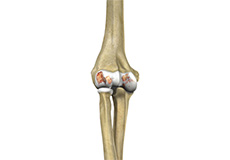
Arthritis of the Elbow
Although the elbows are not weight-bearing joints, they are important for the proper functioning of the upper limb. Hence, even minor trauma or disease affecting the elbow may cause pain and limit movement of the upper limbs. Arthritis is one of the common conditions affecting the elbow joint.
Signs and Symptoms of Elbow Arthritis
Elbow arthritis is an inflammatory condition that causes pain, swelling, stiffness, and interference with use of the arm.
Causes of Elbow Arthritis
Arthritis can affect all ages but is most commonly seen in people aged over 40 years. The most common cause is osteoarthritis which may be related to wear and tear. Apart from that, traumatic injuries, fractures, and dislocations make you more susceptible to arthritis. Rheumatoid arthritis is an systemic inflammatory condition that may involve the elbow joint in addition to other joints throughout the body.
Types of Arthritis
There are several types of arthritis, the most common being:
- Osteoarthritis or degenerative joint disease is the most common type of arthritis that affects the elderly. It causes the cartilage, the tissue that cushions and protects the ends of bones in a joint, to wear off, causing painful rubbing of the bones.
- Rheumatoid arthritis is an autoimmune disease in which the body’s immune system attacks healthy joints, tissues, and organs. It can cause pain, stiffness, swelling, deformity, and loss of function in the joints.
- Post-traumatic arthritis develops after an injury to the elbow. The condition may develop years after the trauma such as a fracture, severe sprain or ligament tears.
- Psoriatic arthritis is another type of inflammatory arthritis which may be seen in association with psoriasis, a scaling skin disorder.
Diagnosis of Elbow Arthritis
Arthritis in the elbow is diagnosed by a thorough physical examination and X-ray.
Treatment Options for Elbow Arthritis
Treatment can include conservative options such as activity modification and medications and steroid injections to relieve pain. Surgery is only considered if non-surgical treatment fails to offer relief. Potential surgical options include synovectomy, osteophyte debridement and loose body removal. The goal of these procedures is to improve pain and help restore motion and funcgtion. For certain patients, total elbow replacement may be an option. In total elbow replacement surgery, the damaged regions of the elbow joint are replaced with artificial components.
Related Topics
- Triceps Injuries
- Osteochondritis Dissecans of the Capitellum
- Elbow Trauma
- Elbow Arthritis
- Bicep Tendon Tear at the Elbow
- Elbow Dislocation
- Triceps Tendonitis
- Elbow (Olecranon) Bursitis
- Elbow Sprain
- Tennis Elbow
- Golfer's Elbow
- Little League Elbow
- Nursemaid's Elbow
- Elbow Pain
- Elbow Contracture
- Distal Humerus Fractures of the Elbow
- Radial Head Fractures of the Elbow
- Elbow Fractures
- Ulnar Nerve Neuropathy
- Loose Bodies in the Elbow
- Radial Tunnel Syndrome
- Lateral Ulnar Collateral Ligament Injuries (Elbow)
- Post-traumatic Stiffness (Elbow)
- Cubital Tunnel Syndrome (Ulnar Nerve Entrapment)





